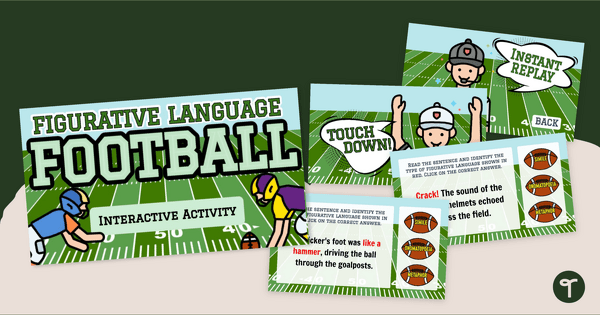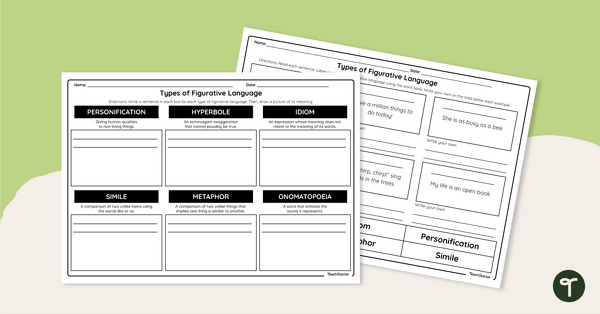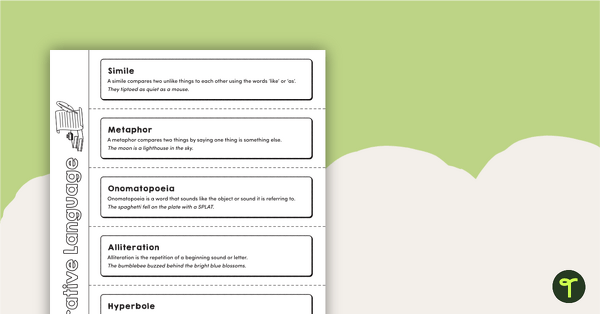Figurative Language Teaching Resources
You use figurative language in your classroom every day, but if you are on the hunt for figurative language worksheets, chances are you are struggling to find good resources for your lesson plans. Our teacher-created resource collection has you covered with instructional slide decks about idioms, onomatopoeia writing activities, figurative language anchor charts and more figurative fun.
Each resource has been reviewed by the teachers on the Teach Starter team to ensure it's curriculum-aligned so students can meet Common Core and state-level standards.
Hey, we don't all teach the same classes every year, and between the list of students with peanut allergies and the latest mandate from administration, you've got a lot of information already packed into your brain. Let the expert ELA teachers on our Teach Starter team provide a quick refresher course. (Already know the answer? Feel free to skip right to downloading the printable activities and worksheets!)
What Is Figurative Language? A Kid-Friendly Definition
Do you need a simple way to explain what figurative language is to your students? Try this definition from our teacher team:
Figurative language is the term we use to describe words that aren't literally or strictly true in order to convey meaning. Wait, huh?
Think of it this way — if you say your friend says the homework was a piece of cake, you know they're using an idiom, but you also know what they mean. That's using figurative language!
Literal Language vs. Figurative Language — What's the Difference?
Figurative language gives meaning to something by referencing something else. So how is it different from literal language?
Literal language is more explicit.
Let's take the "piece of cake" example above.
If that student were being literal, they could have simply said, "That homework was so easy!"
While figurative language is more colorful and fun for the reader, it can also make reading comprehension challenging for students, particularly multi-lingual learners.
Something else to consider?
Children's figurative language acquisition and development aren't just crucial for reading and writing — studies show they're also a core part of social and emotional learning as children learn better ways to express their feelings.
And let's face it — metaphors, hyperbole, idioms, and all types of figurative language make reading and writing more engaging and exciting. In turn, helping us encourage students to develop a lifelong love of reading.
Figurative Language Examples for Your Students
As you're sitting down to lesson plan and explore this teaching resource collection, we thought a look at the main figurative language examples might help! Here are examples of all of the types of figurative language that our teacher team has covered in this collection, with editable options that allow you to differentiate lessons to meet the needs of each student in your classroom:
- Similes
- Metaphors
- Personification
- Alliteration
- Onomatopoeia
- Idioms
- Oxymorons
- Hyperbole
- Free Plan

Metaphors Worksheet
Practice identifying and using metaphors with this differentiated metaphors worksheet.
- Plus Plan

Figurative Language Anchor Charts
Display the types of figurative language with a set of printable figurative language anchor chars.
- Free Plan

Onomatopoeia Words - Vocabulary Display
Display a fun onomatopoeia word wall in your classroom with printable cards containing onomatopoeia examples.
- Free Plan

Simile and Metaphor Self-Portrait Worksheet
Teach students about similes and metaphors by asking them to describe... themselves!
- Plus Plan

Figurative Language Football Interactive Activity
Have a Figurative Language bowl review with this self-checking Google interactive activity.
- Plus Plan

Literary Devices Posters
Explore the various literary devices used by authors with the set of colorful classroom posters.
- Plus Plan

Figurative Languages Lesson - Slide Deck
Teach figurative language using our comprehensive instructional slide deck and accompanying activities.
- Plus Plan

Interesting Idioms Worksheets
Teach figurative language with these idioms worksheets that will introduce your students to many of the most commonly used idioms.
- Plus Plan

Idioms Poster
Hang this idioms poster in your classroom to give your students a reference for this important piece of figurative language.
- Plus Plan

Similes Matching Game
Use this similes game to introduce your students to some of the most common similes used in the English language.
- Plus Plan

Grandparents' Day Activity - Simile Spinner Craft
Show Grandma and Grandpa how awesome they are with a Grandparents’ Day Simile Spinner!
- Plus Plan

Roll and Find – Figurative Language Worksheet
Explore, identify and interpret figurative language with this engaging roll and find activity.
- Plus Plan

Types of Figurative Language - Worksheet
Practice identifying and creating examples of figurative language with this printable worksheet.
- Plus Plan

All About Me! Simile Poem Poster and Worksheet
Get to know your students and explore poetry at the same time with this simile poem scaffolding template.
- Plus Plan

Simile Poster (Primary)
Show your students an example of a simile using this colorful classroom display poster.
- Plus Plan

Figurative Language Flip Book
Practice identify examples of figurative language with this flip book template for kids.
- Plus Plan

Poetry and Figurative Language Workbook - Poems for Middle School
Print a pack of poems with figurative language worksheets to practice poetry analysis.
- Plus Plan

Google Slides Interactive - Idioms Activity
Build vocabulary and have fun with an interactive Idioms activity.
- Plus Plan

Idioms Four in a Row Game
Practice identifying the meaning of common idioms with an exciting game of Four-in-a-Row!
- Plus Plan

Idioms Dominoes
Build vocabulary and have fun with idiom games.
- Plus Plan

Idioms Go Fish Card Game
Understand the meaning of common idioms with a classroom game of Idioms-Go Fish!
- Plus Plan

Idioms Bingo Game
Build vocabulary and have fun with a classroom game of Idiom Bingo.
- Plus Plan

Figurative Language Telephone Game
Play this figurative language game with a group to practice recognizing and inventing metaphors, similes, and personification.
- Plus Plan

I Have a Dream - Speech Analysis Activity
Review MLK's "I Have a Dream" speech text and explore the metaphors he used to convey his message through the accompanying questions.
- Plus Plan

Idioms: What Are They and What Do They Mean? PowerPoint
An editable PowerPoint presentation to use when teaching idioms.
- Plus Plan

Identifying Idioms and Their Meanings - Worksheet
A worksheet to practice identifying idioms and their meaning.
- Plus Plan

Go Figure! - Figurative Language Game
Practice working with different types of figurative language with this hands-on board game.
- Plus Plan

Figurative Language Sorting Activity
Explore figurative language in context with this set of 28 sorting cards.
- Plus Plan

What Does It Really Mean? - Hyperbole Task Cards
Identify and interpret hyperboles used in sentences.
- Plus Plan

Figurative Language - SCOOT! Task Cards
Explore figurative language in multiple ways with the set of 24 task cards.
- Plus Plan

Figurative Language Anchor Chart - Onomatopoeia
Help young readers and writers recognize figurative language and onomatopoeia with a set of onomatopoeia anchor charts.
- Plus Plan

Interpreting Figurative Language - Worksheets
Explore figurative language in poetry with this age-appropriate poem and accompanying vocabulary questions.